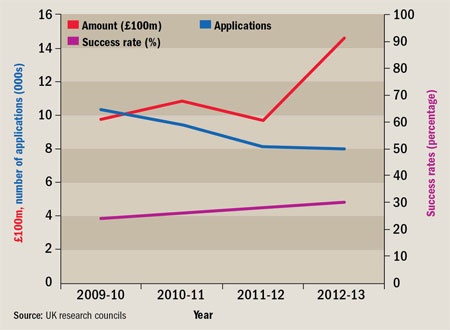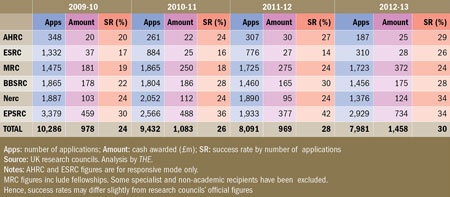The research councils’ controversial demand management measures have been credited with driving the fourth successive annual rise in the overall success rate for grant applications, which now stands at 30 per cent.
Every council now has a success rate of at least 24 per cent, calculated by the number of applications. Overall rates have risen steadily from a low of 23 per cent in 2008‑09.
Demand management was introduced in 2010 by the Engineering and Physical Sciences Research Council, which “constrains” repeatedly unsuccessful applicants to one bid in the 12 months after being singled out. Most other councils require universities to sift their applications before submitting them.
The Economic and Social Research Council’s success rate for “responsive mode” applications (the only mode for which detailed figures are available) rose from 14 per cent in 2011-12 to 26 per cent in 2012-13. An ESRC spokeswoman said that this reflected the phasing-out of its small grants scheme and an increase in the amount allocated to responsive mode grants, as well as the demand management measures it introduced in 2011.
She added that universities “are taking demand management seriously and have introduced systematic sifting mechanisms”.
Cutting off ‘poor-quality tail’
Tim Jones, pro vice-chancellor for research in science and medicine at the University of Warwick, said that although he understood why some colleagues “still probably hate” demand management, it had become widely accepted and had eliminated the “tail of really poor-quality proposals that used to exist”.
He said that success rates of about one in three represented an ideal balance between ensuring that only high-quality applications were funded and limiting the wasted effort that went into rejected bids.
The Natural Environment Research Council’s success rate has risen by 10 percentage points after it announced measures in early 2012 to agree targets with individual universities to reduce uncompetitive applications (with sanctions threatened for failure to meet them).
Its rate of 34 per cent is joint highest with the EPSRC’s.
The success rate for the EPSRC (which is now constraining applications from 16 researchers, compared with 115 when demand management was introduced) fell from 42 per cent in 2011-12. The value of its awards nearly doubled, but the number of applications rose by 52 per cent.
A council spokesman said that the body had invited applications for a “planned pulse” of funding in 2012-13. Given that the EPSRC is the single biggest funder, this was the main reason for a 50 per cent rise in the total value of research council grants (to nearly £1.5 billion).
Only the smallest spender, the Arts and Humanities Research Council, records a slight fall.
However, the science budget will remain flat until at least 2015-16. Nick Wright, pro vice-chancellor for research at Newcastle University, said that although his institution’s awards had more than doubled in value, he was worried about the future, particularly beyond the next spending review.
“Most colleagues in other universities would say the same,” he said.
See data, below. Click here for the full data tables
Register to continue
Why register?
- Registration is free and only takes a moment
- Once registered, you can read 3 articles a month
- Sign up for our newsletter
Subscribe
Or subscribe for unlimited access to:
- Unlimited access to news, views, insights & reviews
- Digital editions
- Digital access to THE’s university and college rankings analysis
Already registered or a current subscriber? Login






